Literature Review: Employee Recruitment and Retention in Healthcare HR
VerifiedAdded on 2022/09/28
|6
|1466
|25
Literature Review
AI Summary
This literature review examines the critical aspects of healthcare human resource management, with a specific focus on employee recruitment and retention strategies. The paper delves into the significance of talent acquisition, highlighting various approaches organizations employ to attract and secure the best-fit candidates. It explores the challenges of recruiting qualified individuals and emphasizes the importance of developing and retaining top talent to ensure organizational success. The review encompasses a comprehensive analysis of existing literature, discussing key concepts such as effective communication, workforce diversity, talent development plans, and organizational culture. It also examines the impact of recruitment processes, retention strategies, and the role of compensation and career development in minimizing employee turnover. The paper concludes by underscoring the significance of a well-defined recruitment process and the implementation of effective employee retention strategies to foster organizational growth and stability within the healthcare sector.
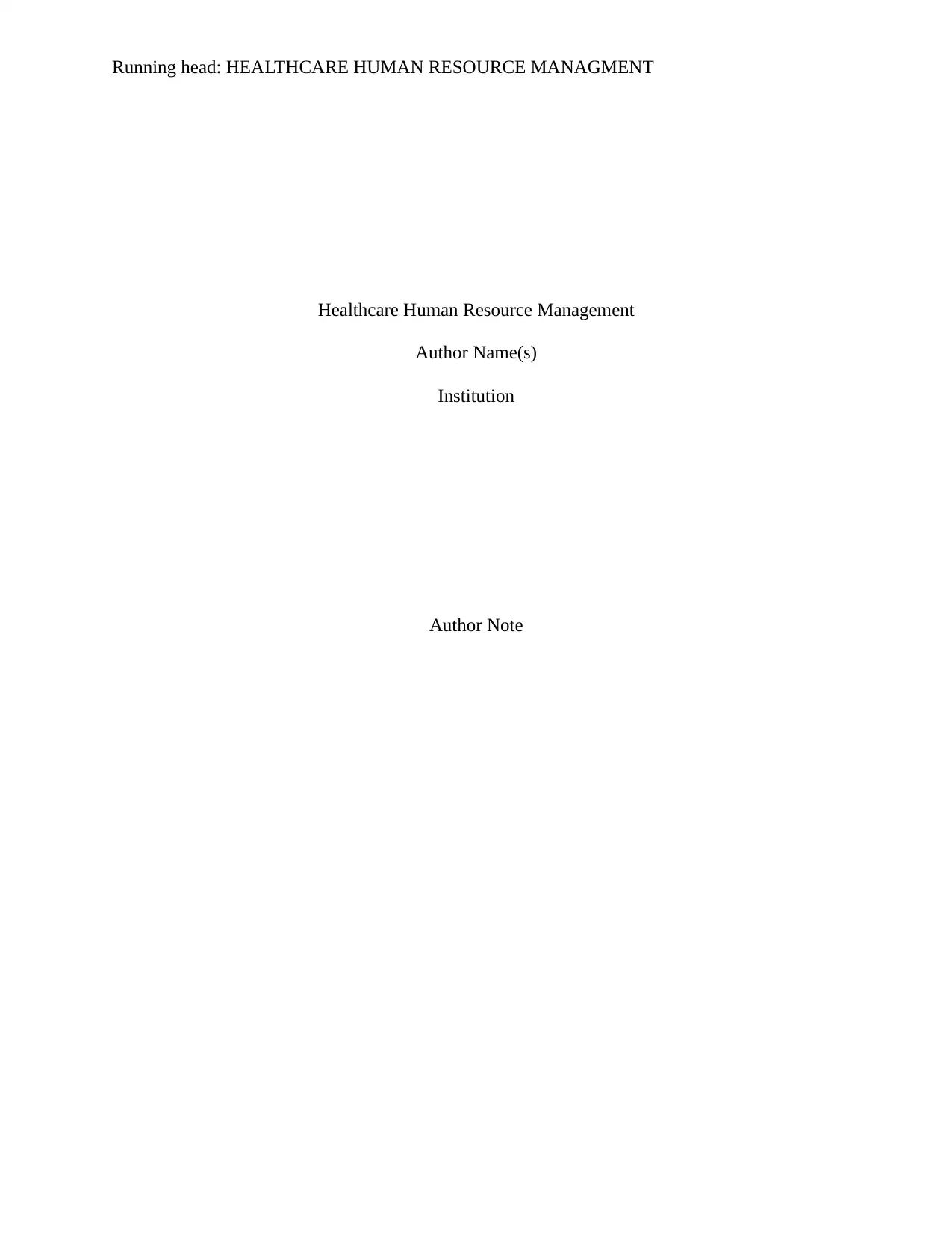
Running head: HEALTHCARE HUMAN RESOURCE MANAGMENT
Healthcare Human Resource Management
Author Name(s)
Institution
Author Note
Healthcare Human Resource Management
Author Name(s)
Institution
Author Note
Paraphrase This Document
Need a fresh take? Get an instant paraphrase of this document with our AI Paraphraser
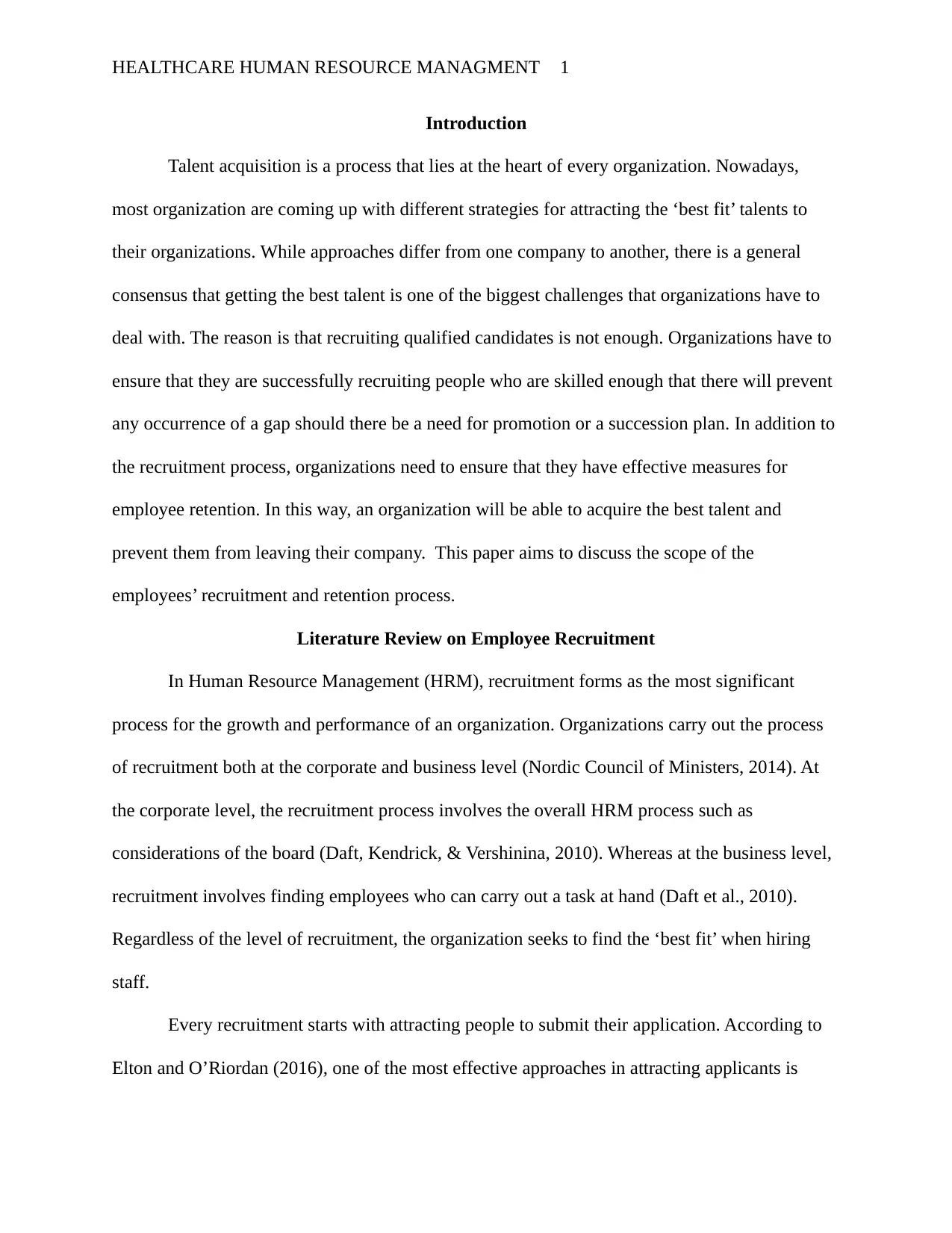
HEALTHCARE HUMAN RESOURCE MANAGMENT 1
Introduction
Talent acquisition is a process that lies at the heart of every organization. Nowadays,
most organization are coming up with different strategies for attracting the ‘best fit’ talents to
their organizations. While approaches differ from one company to another, there is a general
consensus that getting the best talent is one of the biggest challenges that organizations have to
deal with. The reason is that recruiting qualified candidates is not enough. Organizations have to
ensure that they are successfully recruiting people who are skilled enough that there will prevent
any occurrence of a gap should there be a need for promotion or a succession plan. In addition to
the recruitment process, organizations need to ensure that they have effective measures for
employee retention. In this way, an organization will be able to acquire the best talent and
prevent them from leaving their company. This paper aims to discuss the scope of the
employees’ recruitment and retention process.
Literature Review on Employee Recruitment
In Human Resource Management (HRM), recruitment forms as the most significant
process for the growth and performance of an organization. Organizations carry out the process
of recruitment both at the corporate and business level (Nordic Council of Ministers, 2014). At
the corporate level, the recruitment process involves the overall HRM process such as
considerations of the board (Daft, Kendrick, & Vershinina, 2010). Whereas at the business level,
recruitment involves finding employees who can carry out a task at hand (Daft et al., 2010).
Regardless of the level of recruitment, the organization seeks to find the ‘best fit’ when hiring
staff.
Every recruitment starts with attracting people to submit their application. According to
Elton and O’Riordan (2016), one of the most effective approaches in attracting applicants is
Introduction
Talent acquisition is a process that lies at the heart of every organization. Nowadays,
most organization are coming up with different strategies for attracting the ‘best fit’ talents to
their organizations. While approaches differ from one company to another, there is a general
consensus that getting the best talent is one of the biggest challenges that organizations have to
deal with. The reason is that recruiting qualified candidates is not enough. Organizations have to
ensure that they are successfully recruiting people who are skilled enough that there will prevent
any occurrence of a gap should there be a need for promotion or a succession plan. In addition to
the recruitment process, organizations need to ensure that they have effective measures for
employee retention. In this way, an organization will be able to acquire the best talent and
prevent them from leaving their company. This paper aims to discuss the scope of the
employees’ recruitment and retention process.
Literature Review on Employee Recruitment
In Human Resource Management (HRM), recruitment forms as the most significant
process for the growth and performance of an organization. Organizations carry out the process
of recruitment both at the corporate and business level (Nordic Council of Ministers, 2014). At
the corporate level, the recruitment process involves the overall HRM process such as
considerations of the board (Daft, Kendrick, & Vershinina, 2010). Whereas at the business level,
recruitment involves finding employees who can carry out a task at hand (Daft et al., 2010).
Regardless of the level of recruitment, the organization seeks to find the ‘best fit’ when hiring
staff.
Every recruitment starts with attracting people to submit their application. According to
Elton and O’Riordan (2016), one of the most effective approaches in attracting applicants is
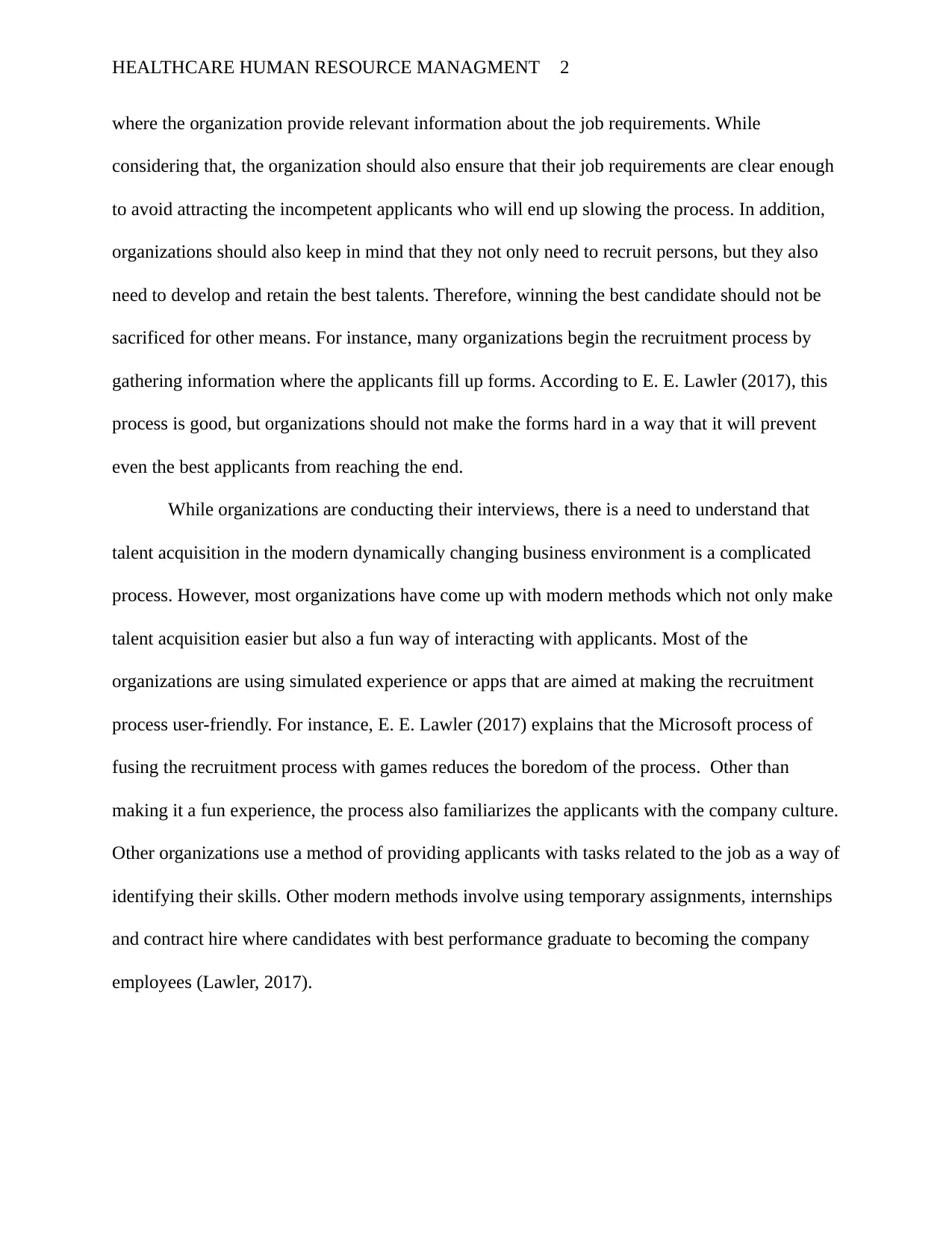
HEALTHCARE HUMAN RESOURCE MANAGMENT 2
where the organization provide relevant information about the job requirements. While
considering that, the organization should also ensure that their job requirements are clear enough
to avoid attracting the incompetent applicants who will end up slowing the process. In addition,
organizations should also keep in mind that they not only need to recruit persons, but they also
need to develop and retain the best talents. Therefore, winning the best candidate should not be
sacrificed for other means. For instance, many organizations begin the recruitment process by
gathering information where the applicants fill up forms. According to E. E. Lawler (2017), this
process is good, but organizations should not make the forms hard in a way that it will prevent
even the best applicants from reaching the end.
While organizations are conducting their interviews, there is a need to understand that
talent acquisition in the modern dynamically changing business environment is a complicated
process. However, most organizations have come up with modern methods which not only make
talent acquisition easier but also a fun way of interacting with applicants. Most of the
organizations are using simulated experience or apps that are aimed at making the recruitment
process user-friendly. For instance, E. E. Lawler (2017) explains that the Microsoft process of
fusing the recruitment process with games reduces the boredom of the process. Other than
making it a fun experience, the process also familiarizes the applicants with the company culture.
Other organizations use a method of providing applicants with tasks related to the job as a way of
identifying their skills. Other modern methods involve using temporary assignments, internships
and contract hire where candidates with best performance graduate to becoming the company
employees (Lawler, 2017).
where the organization provide relevant information about the job requirements. While
considering that, the organization should also ensure that their job requirements are clear enough
to avoid attracting the incompetent applicants who will end up slowing the process. In addition,
organizations should also keep in mind that they not only need to recruit persons, but they also
need to develop and retain the best talents. Therefore, winning the best candidate should not be
sacrificed for other means. For instance, many organizations begin the recruitment process by
gathering information where the applicants fill up forms. According to E. E. Lawler (2017), this
process is good, but organizations should not make the forms hard in a way that it will prevent
even the best applicants from reaching the end.
While organizations are conducting their interviews, there is a need to understand that
talent acquisition in the modern dynamically changing business environment is a complicated
process. However, most organizations have come up with modern methods which not only make
talent acquisition easier but also a fun way of interacting with applicants. Most of the
organizations are using simulated experience or apps that are aimed at making the recruitment
process user-friendly. For instance, E. E. Lawler (2017) explains that the Microsoft process of
fusing the recruitment process with games reduces the boredom of the process. Other than
making it a fun experience, the process also familiarizes the applicants with the company culture.
Other organizations use a method of providing applicants with tasks related to the job as a way of
identifying their skills. Other modern methods involve using temporary assignments, internships
and contract hire where candidates with best performance graduate to becoming the company
employees (Lawler, 2017).
⊘ This is a preview!⊘
Do you want full access?
Subscribe today to unlock all pages.

Trusted by 1+ million students worldwide
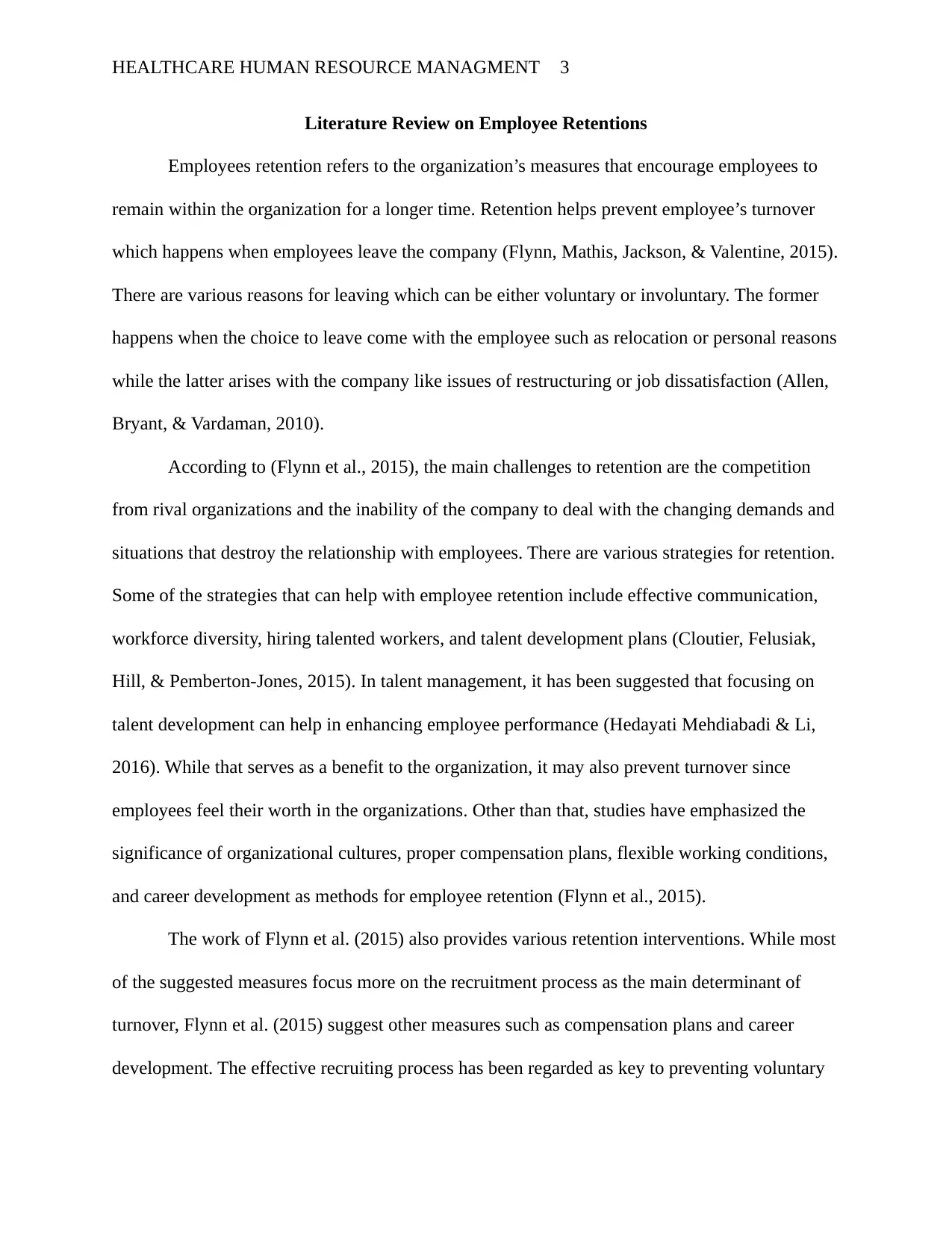
HEALTHCARE HUMAN RESOURCE MANAGMENT 3
Literature Review on Employee Retentions
Employees retention refers to the organization’s measures that encourage employees to
remain within the organization for a longer time. Retention helps prevent employee’s turnover
which happens when employees leave the company (Flynn, Mathis, Jackson, & Valentine, 2015).
There are various reasons for leaving which can be either voluntary or involuntary. The former
happens when the choice to leave come with the employee such as relocation or personal reasons
while the latter arises with the company like issues of restructuring or job dissatisfaction (Allen,
Bryant, & Vardaman, 2010).
According to (Flynn et al., 2015), the main challenges to retention are the competition
from rival organizations and the inability of the company to deal with the changing demands and
situations that destroy the relationship with employees. There are various strategies for retention.
Some of the strategies that can help with employee retention include effective communication,
workforce diversity, hiring talented workers, and talent development plans (Cloutier, Felusiak,
Hill, & Pemberton-Jones, 2015). In talent management, it has been suggested that focusing on
talent development can help in enhancing employee performance (Hedayati Mehdiabadi & Li,
2016). While that serves as a benefit to the organization, it may also prevent turnover since
employees feel their worth in the organizations. Other than that, studies have emphasized the
significance of organizational cultures, proper compensation plans, flexible working conditions,
and career development as methods for employee retention (Flynn et al., 2015).
The work of Flynn et al. (2015) also provides various retention interventions. While most
of the suggested measures focus more on the recruitment process as the main determinant of
turnover, Flynn et al. (2015) suggest other measures such as compensation plans and career
development. The effective recruiting process has been regarded as key to preventing voluntary
Literature Review on Employee Retentions
Employees retention refers to the organization’s measures that encourage employees to
remain within the organization for a longer time. Retention helps prevent employee’s turnover
which happens when employees leave the company (Flynn, Mathis, Jackson, & Valentine, 2015).
There are various reasons for leaving which can be either voluntary or involuntary. The former
happens when the choice to leave come with the employee such as relocation or personal reasons
while the latter arises with the company like issues of restructuring or job dissatisfaction (Allen,
Bryant, & Vardaman, 2010).
According to (Flynn et al., 2015), the main challenges to retention are the competition
from rival organizations and the inability of the company to deal with the changing demands and
situations that destroy the relationship with employees. There are various strategies for retention.
Some of the strategies that can help with employee retention include effective communication,
workforce diversity, hiring talented workers, and talent development plans (Cloutier, Felusiak,
Hill, & Pemberton-Jones, 2015). In talent management, it has been suggested that focusing on
talent development can help in enhancing employee performance (Hedayati Mehdiabadi & Li,
2016). While that serves as a benefit to the organization, it may also prevent turnover since
employees feel their worth in the organizations. Other than that, studies have emphasized the
significance of organizational cultures, proper compensation plans, flexible working conditions,
and career development as methods for employee retention (Flynn et al., 2015).
The work of Flynn et al. (2015) also provides various retention interventions. While most
of the suggested measures focus more on the recruitment process as the main determinant of
turnover, Flynn et al. (2015) suggest other measures such as compensation plans and career
development. The effective recruiting process has been regarded as key to preventing voluntary
Paraphrase This Document
Need a fresh take? Get an instant paraphrase of this document with our AI Paraphraser
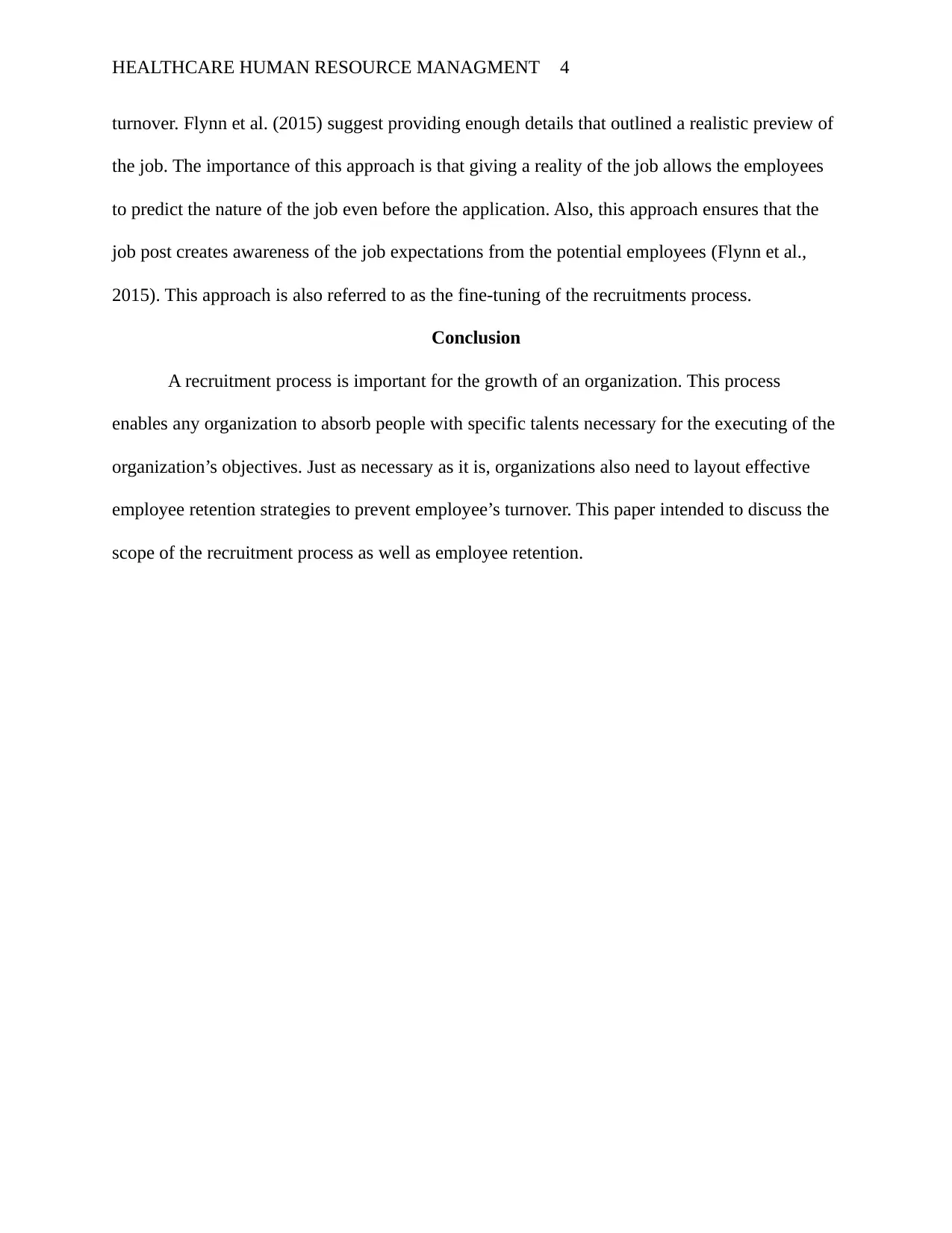
HEALTHCARE HUMAN RESOURCE MANAGMENT 4
turnover. Flynn et al. (2015) suggest providing enough details that outlined a realistic preview of
the job. The importance of this approach is that giving a reality of the job allows the employees
to predict the nature of the job even before the application. Also, this approach ensures that the
job post creates awareness of the job expectations from the potential employees (Flynn et al.,
2015). This approach is also referred to as the fine-tuning of the recruitments process.
Conclusion
A recruitment process is important for the growth of an organization. This process
enables any organization to absorb people with specific talents necessary for the executing of the
organization’s objectives. Just as necessary as it is, organizations also need to layout effective
employee retention strategies to prevent employee’s turnover. This paper intended to discuss the
scope of the recruitment process as well as employee retention.
turnover. Flynn et al. (2015) suggest providing enough details that outlined a realistic preview of
the job. The importance of this approach is that giving a reality of the job allows the employees
to predict the nature of the job even before the application. Also, this approach ensures that the
job post creates awareness of the job expectations from the potential employees (Flynn et al.,
2015). This approach is also referred to as the fine-tuning of the recruitments process.
Conclusion
A recruitment process is important for the growth of an organization. This process
enables any organization to absorb people with specific talents necessary for the executing of the
organization’s objectives. Just as necessary as it is, organizations also need to layout effective
employee retention strategies to prevent employee’s turnover. This paper intended to discuss the
scope of the recruitment process as well as employee retention.
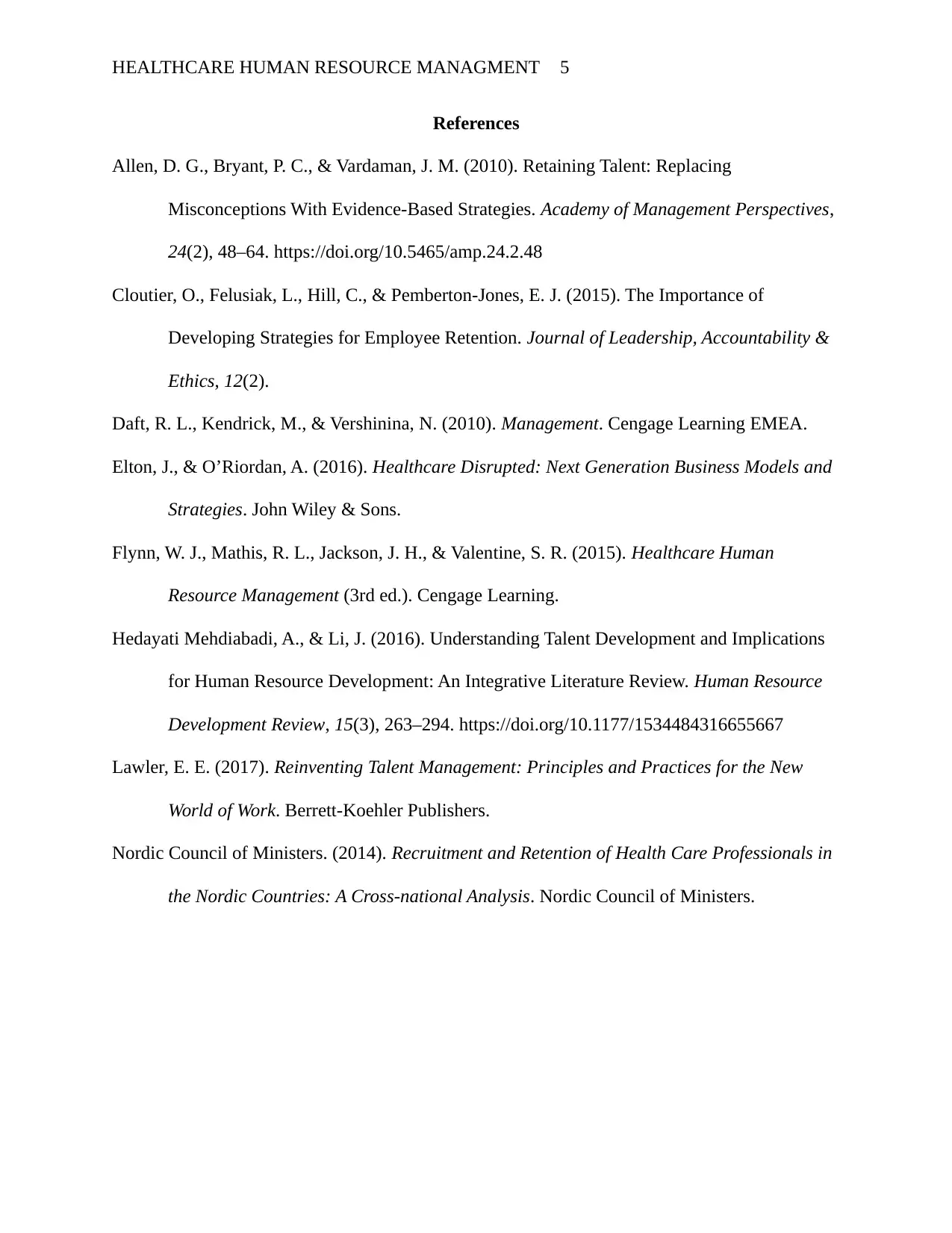
HEALTHCARE HUMAN RESOURCE MANAGMENT 5
References
Allen, D. G., Bryant, P. C., & Vardaman, J. M. (2010). Retaining Talent: Replacing
Misconceptions With Evidence-Based Strategies. Academy of Management Perspectives,
24(2), 48–64. https://doi.org/10.5465/amp.24.2.48
Cloutier, O., Felusiak, L., Hill, C., & Pemberton-Jones, E. J. (2015). The Importance of
Developing Strategies for Employee Retention. Journal of Leadership, Accountability &
Ethics, 12(2).
Daft, R. L., Kendrick, M., & Vershinina, N. (2010). Management. Cengage Learning EMEA.
Elton, J., & O’Riordan, A. (2016). Healthcare Disrupted: Next Generation Business Models and
Strategies. John Wiley & Sons.
Flynn, W. J., Mathis, R. L., Jackson, J. H., & Valentine, S. R. (2015). Healthcare Human
Resource Management (3rd ed.). Cengage Learning.
Hedayati Mehdiabadi, A., & Li, J. (2016). Understanding Talent Development and Implications
for Human Resource Development: An Integrative Literature Review. Human Resource
Development Review, 15(3), 263–294. https://doi.org/10.1177/1534484316655667
Lawler, E. E. (2017). Reinventing Talent Management: Principles and Practices for the New
World of Work. Berrett-Koehler Publishers.
Nordic Council of Ministers. (2014). Recruitment and Retention of Health Care Professionals in
the Nordic Countries: A Cross-national Analysis. Nordic Council of Ministers.
References
Allen, D. G., Bryant, P. C., & Vardaman, J. M. (2010). Retaining Talent: Replacing
Misconceptions With Evidence-Based Strategies. Academy of Management Perspectives,
24(2), 48–64. https://doi.org/10.5465/amp.24.2.48
Cloutier, O., Felusiak, L., Hill, C., & Pemberton-Jones, E. J. (2015). The Importance of
Developing Strategies for Employee Retention. Journal of Leadership, Accountability &
Ethics, 12(2).
Daft, R. L., Kendrick, M., & Vershinina, N. (2010). Management. Cengage Learning EMEA.
Elton, J., & O’Riordan, A. (2016). Healthcare Disrupted: Next Generation Business Models and
Strategies. John Wiley & Sons.
Flynn, W. J., Mathis, R. L., Jackson, J. H., & Valentine, S. R. (2015). Healthcare Human
Resource Management (3rd ed.). Cengage Learning.
Hedayati Mehdiabadi, A., & Li, J. (2016). Understanding Talent Development and Implications
for Human Resource Development: An Integrative Literature Review. Human Resource
Development Review, 15(3), 263–294. https://doi.org/10.1177/1534484316655667
Lawler, E. E. (2017). Reinventing Talent Management: Principles and Practices for the New
World of Work. Berrett-Koehler Publishers.
Nordic Council of Ministers. (2014). Recruitment and Retention of Health Care Professionals in
the Nordic Countries: A Cross-national Analysis. Nordic Council of Ministers.
⊘ This is a preview!⊘
Do you want full access?
Subscribe today to unlock all pages.

Trusted by 1+ million students worldwide
1 out of 6
Related Documents
Your All-in-One AI-Powered Toolkit for Academic Success.
+13062052269
info@desklib.com
Available 24*7 on WhatsApp / Email
![[object Object]](/_next/static/media/star-bottom.7253800d.svg)
Unlock your academic potential
Copyright © 2020–2025 A2Z Services. All Rights Reserved. Developed and managed by ZUCOL.




